How to Stop Programs from Running at Startup on Windows 7
After a Windows computer starts up, each member of a specific group of programs on the computer is launched as soon as the user logs in to Windows. These “startup items” range from third-party programs installed by the user that are configured to launch at startup to built-in Windows programs that the system needs to be running when it boots up. Windows is an Operating System that hands over complete control of a computer to its user. That being the case, Windows users also have authority over what programs start running at startup and which ones do not.
Windows users sometimes need to stop certain programs from running at startup for a wide variety of reasons (from the target program being malicious or otherwise dangerous to the target program eating up a lot of computer resources after it is launched at startup to everything in between). Thankfully, preventing a program from running at startup on a computer running on Windows 7 is fairly easy. However, there are three different methods a Windows 7 user can go about preventing a program or application on their computer from running at startup.
These three methods are also to be used in succession until one of these methods manages to fulfill the objective. For example, if the first method doesn’t work, only then should you move on to the second method and then the third method until you successfully prevent the target program from running at startup. The following are the three methods being talked about:
Method 1: Deleting the program’s shortcut from the Startup folder
Most third-party programs that are configured to launch at startup have a shortcut in the Startup folder of a Windows computer. Deleting this shortcut from the Startup folder results in Windows not launching the program at boot. On Windows 7, here’s what you need to do in order to delete a program’s shortcut from the Startup folder to prevent it from running at startup:
- Open the Start Menu.

- Click on All Programs.
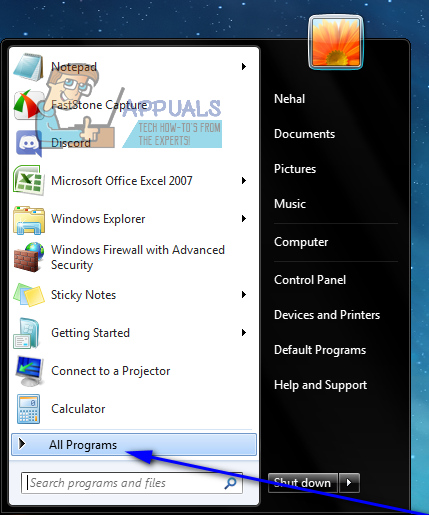
- Locate and click on the Startup folder to expand it.
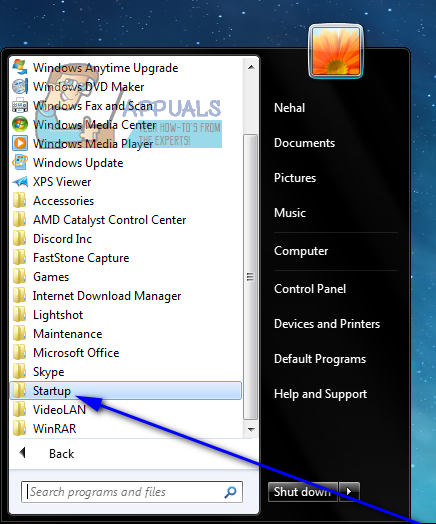
- Look for a shortcut to your target program or application under the Startup folder. Once you locate the shortcut, right-click on it and click on Delete.
- Confirm the action in the resulting popup.
- Restart your computer and check to make sure the program doesn’t launch when the computer boots up.
Method 2: Disable the startup item in System Configuration
If deleting the target program’s shortcut from the Startup folder doesn’t work or if you find that a shortcut for the target program doesn’t even exist in your computer’s Startup folder, fear not – it is still entirely possible for you to disable the target program or “startup item” from System Configuration. System Configuration is a Windows utility designed to allow users to configure how their computer starts up and shuts down, among an array of other things. To disable the target “startup item” in System Configuration to prevent the target program from being launched at startup, you need to:
- Press the Windows Logo key + R to open a Run dialog.

- Type msconfig into the Run dialog and press Enter to launch the System Configuration utility.
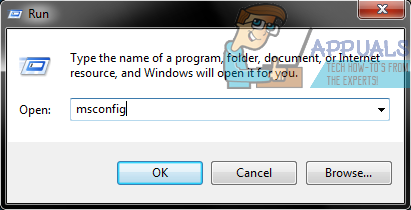
- Navigate to the Startup tab of the System Configuration utility.

- Locate the program Windows from launching when your computer starts up, and disable it by unchecking the checkbox located directly next to it.
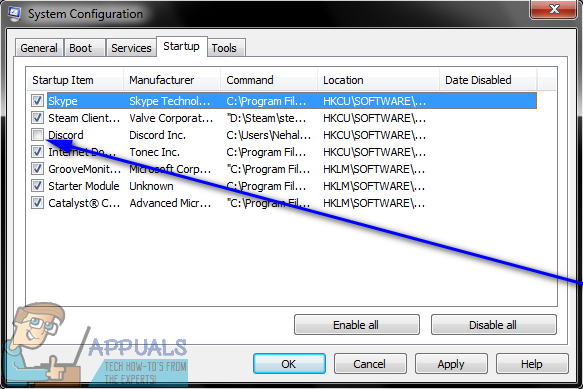
- Click on Apply and then on OK.
- Click on Restart in the resulting dialog box.
- When the computer boots up, check to make sure Windows doesn’t launch the program you just disabled in System Configuration.
Method 3: Prevent the offending program from launching at startup using the Registry
Apart from the Startup folder on your computer and System Configuration, the Registry also has the ability to get Windows to launch certain programs at the startup. That being the case, you can only prevent some programs from launching at startup if you do so via the Registry on your computer. Make sure to back up your Registry before trying to edit it in case something goes wrong. To prevent a program from being launched at startup using the Registry, simply:
- Start the registry editor.
- Press the Windows Logo key + R to open a Run dialog.

- Type regedit into the Run dialog and press Enter to launch the Registry Editor.

- In the left pane of the Registry Editor, navigate to the following directory:
HKEY LOCAL MACHINE > SOFTWARE > Microsoft> Windows > CurrentVersion
- In the left pane of the Registry Editor, click on the Run sub-key under the CurrentVersion key to have its contents displayed in the right pane.

- In the right pane of the Registry Editor, you are going to see listings for all of the programs on your computer that are configured to be launched at startup through the Registry. Locate the listing for the program you want to prevent Windows from launching at startup, right-click on it and click on Delete.
- Confirm the action in the resulting popup.
- Close the Registry Editor.
- Restart your computer. At startup, check to ensure that Windows does not automatically launch the program you just disabled from being launched at startup.
Note: Deleting a program or application’s entry from the Run sub-key in the Registry Editor only prevents the program from being launched at startup – it does NOT uninstall the program from your computer.
Method 4: Adjusting in MSConfig
It is possible in some cases that the program that you are trying to stop from running or launching at your computer’s startup has also installed a service on your computer that automatically overrides any restrictions that you implement and allows the program to be launched at the startup. Therefore, in this step, we will be adjusting this in the MSConfig window. For that:
- Press “Windows” + “R” to open the Run prompt.
- Type in “MSConfig” and press “Enter” to open the Microsoft Configuration Window.

msconfig - In the Configuration Window, click on the “Services” panel and scroll through the list of mentioned services.
- From this, try to disable a service that seems relevant to the application that you are trying to disable.
- After doing so, hit the “Apply” button to confirm that the service is disabled.
- Check to see if the program still launches.
Method 5: Delete Registry Startup
In some isolated cases, there is another registry where the program that is launching at startup might have manifested its startup command. This registry entry can sometimes contain the command to launch a particular application at startup and in this step, we will be getting rid of the entry to make sure that the application isn’t launched. In order to do so, make sure to back up the registry beforehand in case something goes south.
- Press “Windows” + ” “R” on your keyboard to open the Run prompt.
- Inside the Run prompt, type in “Regedit” and press “Enter” to launch the registry editor.

Open Regedit - In the Registry Editor, navigate to the below mentioned location.
HKEY_LOCAL_MACHINE\SOFTWARE\Microsoft\SharedTools\MSConfig\startupreg
- From here, on the right side, you should see a registry entry for any programs that are currently enabled to run on your computer’s startup.
- Right-click on their entries and select the “Delete” button to remove them from your computer.
- Check to see if doing so has fixed the issue.
Method 6: Disable Startup Programs Using CCleaner
Sometimes, your computer’s configurations might be so messed up that in spite of trying all the fixes above, you would not be able to disable the program that you want from launching at startup. Therefore, sometimes, you will have to go for a third-party solution to completely prevent any program from launching at your computer’s startup. In order to do so, follow the guide below.
- First of all, what you want to do is launch your favorite browser and download the CCleaner program from here.
- After downloading this tool, make sure to press the executable icon and follow through with the on-screen instructions to install it on your computer.
- After the installation process is completed, launch the application on your computer.
- After the application has been started, click on the “Tools” button at the left side of the dialogue box and select the “Startup” button after that.
- The “Enabled” column on the left should be listing the programs that are currently enabled to launch at your computer’s startup.

Clicking on the enabled column - Click on the program that you want to disable from the list and then click on the “Disable” button to prevent it from launching at startup.
- After disabling all the preferred programs, restart your computer to make sure that the change takes effect.
- Check to see if by doing so you have been able to disable the programs.
Method 7: Check Application Settings
In some cases, we have seen that the application in question is configured to launch at startup through its own settings. This option is usually presented when you first install the application and if you don’t change the default “Launch at Startup” option, the application becomes configured to launch at startup. Due to this, even though you are trying to prevent it from starting by changing the computer configurations, it will still override these settings to adjust to your preference. Therefore, a wise workaround to this would be to check your application settings in detail to disable any launch at startup setting.
Method 8: Using Selective Startup
Some users were going through the issue that their computer was unable to function and they were unable to move even the cursor when the computer was starting up because a particular application was breaking down the operating system and causing it to hang up. Therefore, in this step, we will be booting the computer into a selective startup mode and this way, you will be able to properly diagnose which application is causing this issue and then disable it from launching at startup. For that:
- Press “Windows’ + “R’ to open the Run prompt.
- Type in “msconfig” and press “enter” to launch the Microsoft Configuration panel.

msconfig - Inside this panel, click on the “Boot” option, and from here make sure to check the “Safe Boot” option and after that, select the “Minimal” button.
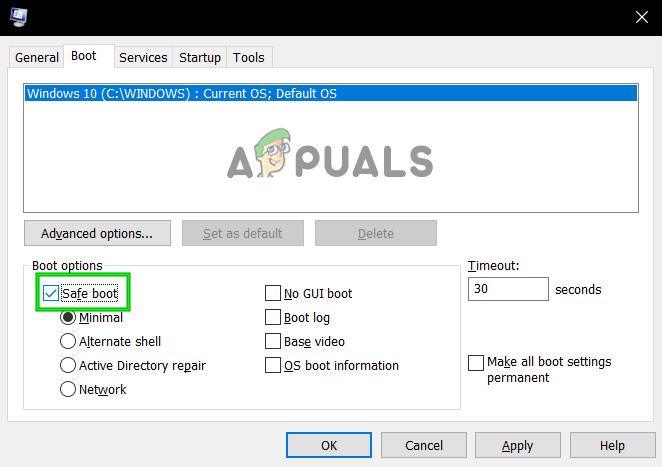
Check Safe Mode in Boot Tab - Click on the “Apply” button to save your changes and then click on the “OK” button to exit out of the window.
- Restart your computer to actually boot into the selective startup mode.
- This mode won’t allow any extra application to start up and you should be able to easily diagnose and fix your computer.
- Check to see if doing so has fixed your issue.
Note: We don’t recommend leaving your computer in selective startup, because this can render portions of your security software or other applications unavailable. Once you have determined which program is causing the problem, you should check the program’s documentation or help site to see if the program can be configured to avoid the conflict.
Method 9: Disable Startup Programs Using iSumSoft System Refixer
Once again, if you are unable to perform any of the steps that we have mentioned below, a convenient and decent approach would be to use the iSumSoft System Refixer tool to actually go through this whole ordeal for you. In order to demonstrate this, we have listed the steps below.
- Launch your favorite browser and download the iSumsoft System Refixer on your computer from here.
- After the download is finished, click on the executable to launch its installer and follow the on-screen instructions to install it on your computer.
- Select the Startup option on the top of this tool and it will display a list of all the programs that have been configured to launch at startup on your computer.

Clicking on the “Startup” tab - Click the ‘Disable start’ button to disable your unwanted startup programs.
- Save your settings and check to see if doing so has gotten rid of your issue.
Method 10: Disable Startup Application Using Shift Key
If you aren’t comfortable with any third-party applications and actually want to perform these steps conveniently at the press of a button, you can just press and hold the Shift key during the startup process of the computer. This will prevent any programs from being able to run after the startup.
On some computers, you need to press and hold the shift key while restarting your computer to actually launch it without having any startup programs enabled so make sure that you try both these methods and see which one works the best for you.
- %SystemDrive%\Users\username\AppData\Roaming\Microsoft\Windows\Start Menu\Programs\Startup
- %SystemDrive%\ProgramData\Microsoft\Windows\Start Menu\Programs\Startup
As we discussed above, the folders above contain the list of the programs that are to be launched at the startup of the computer and whenever the user cues the startup, the system goes into these locations to check for the list but when you press the Shift key, this process is skipped and you are able to bypass that list. In order to do this:
- Log off the computer and then log on again, Immediately press and hold down the Shift key as the computer starts.
- Continue to hold down the Shift key until the desktop icons appear.
- Next, you should use the System Configuration utility to temporarily disable applications one by one until you identify the cause of the problem.
- With the cause of the problem identified, you can fix the application or permanently remove it from your startup programs.
- Check to see if this method works and you are able to prevent the app from starting.